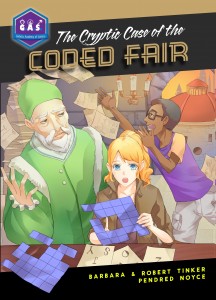The key to engagement in tech is to get children involved at a young age. Maybe there is a child in your life that is interested in puzzles, and just needs the support to know that being nerdy is okay? The most important thing that kept me in the technology field was being given access to classes, games, puzzles and having parents in STEM. An important resource that I wish I’d had, are age appropriate books about computer science. When growing up, there were books about everything from nature to athletics to medicine, but never computing. I am thrilled to see books like this available for kids!
The Cryptic Case of the Coded Fair by Barbara & Robert Tinker and Penny Noyce, is the most recent book in a series for 9-13 year olds about the Galactic Academy of Science (G.A.S.). In this book G.A.S. is attempting to save a science fair from Dr. G, the evil genius who is trying to discredit real science by sending encrypted messages to corrupt judges. In order to crack Dr. G’s messages, two middle schoolers, Ella and Shomari, are recruited to travel through time to learn about different ciphers and codes from different historical figures in encryption. They meet figures like Julius Caesar and Alan Turing, and are taught how they developed different coding techniques. Throughout the book there is also an interactive portion, where students can try out different ciphers with challenges online. Things like interactivity with a book can help expand ideas, while also keeping a child engaged.
While I am a bit beyond the age range for this book, I really enjoyed it! I learned something new while being immersed in a captivating story. Books like this can help children who may be hesitant about computing to see an interesting application, learn more about the field and maybe explore further possibilities.
Julie Hubschman is a junior Interdisciplinary Major in Human-Computer Interaction at Goucher College in Baltimore, MD. She is currently spending a semester in Scotland. She loves tech and robots named Jimmy.


